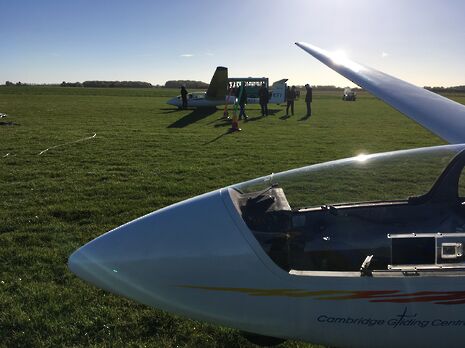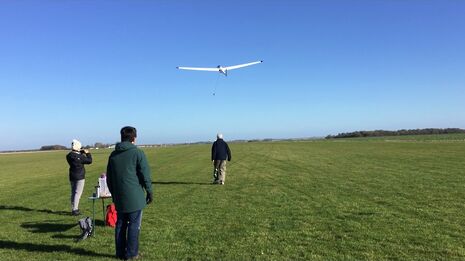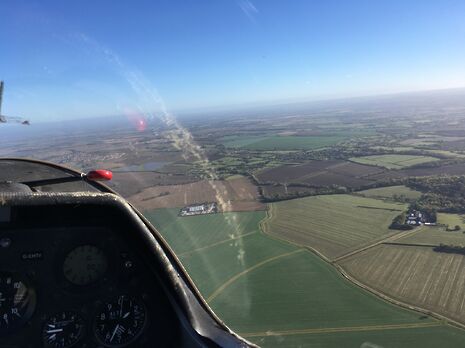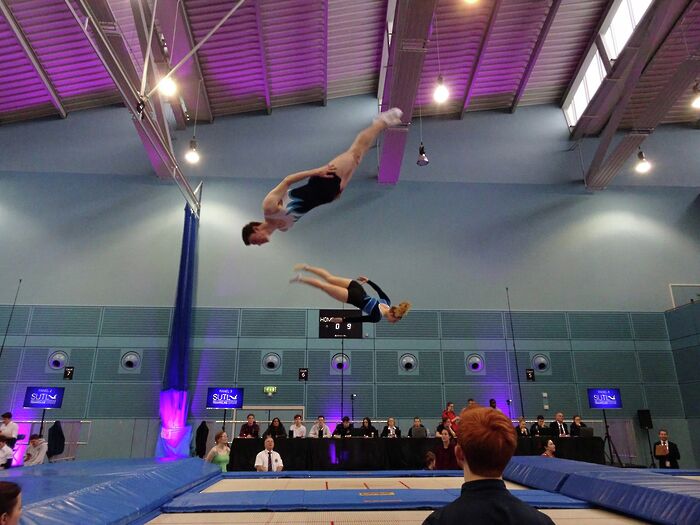Taking wing with the University Gliding Club
With his feet now squarely planted on firm ground, Marcus McCabe recounts his adventures in the skies above Cambridgeshire

The sun was shining as I tore myself out of bed at 7:30am (middle of the night for a humanities student) to catch my lift to the Cambridge Gliding Centre, and by the time we were out on the runway there wasn’t a cloud in the sky – perfect flying conditions.
“At the last minute, we pulled up and our wheels brushed the land – we alighted like a paper plane delicately coming to rest on a front lawn”
However, before we could get up in the air, our first job upon arrival was to carefully unpack the gliders from their hangar, where they were stacked like winged sardines.
Once out, I was given the enviable task of wiping spattered bugs from the leading edges of the glider’s wings. Not just because I was new, I was told, but because they can drastically effect aerodynamics. Apparently.

After the processions of preparations and safety processes, I certainly had a few unreleased butterflies in my stomach as I wrestled my way into a parachute that looked a bit like a primary-school book bag. I was up first.
But in fact, statistically speaking, gliding is an incredibly safe sport – much safer than driving. As we sat on the runway, myself up front, my instructor in the seat behind me, ticking off final checks and readying to take off, I couldn’t wait to get started.
Gliders are launched by a 7.5L engine attached to a winch, which pulls them at great speeds down the runway until they take to the air like a giant kite. The pilot then releases the cable at a few thousand feet and uses natural airflow and thermal currents to fly.
I saw the cord pull taut and we were off, up and away. I had anticipated a drawn-out takeoff like a commercial jet before we were properly airborne. However, the glider whooshed into the air almost immediately, shooting vertically upwards to a few thousand feet in a matter of moments.

One minute we were on the ground and the next, after a surge of G-force, we were looking down on a patchwork of East-Anglian meadows extending off into the horizon on every side. My instructor pointed out a distant wind farm, the speck of a water tower from when the airfield had been a WWII Base for RAF bombers, and a miniature wedding marquee in the grounds of a toy stately home far below us. The engineless glider was so silent that it was easy to forget it was there, and we just soaked up the view.
I was so enraptured by the endless, completely flat, vistas below us that it came as something of a shock when my instructor told me that I was now in control of the plane. The joystick was incredibly sensitive; a nudge up pointed us, Icarus-like, towards the sun, while a nudge downwards sent us plummeting towards the ground. Having levelled us, I was directed to make a series of banks and turns across the Cambridgeshire skies, each one flipping the little aircraft sideways so that the ground filled my side-window. Wheeling across the sky with such delicate control felt like flying. Not just technically flying, packed into the economy class of a 747, but flying like a bird, like in a dream.
All too soon, though, it was time to land. My instructor took back the controls and angled us around to face the runway, tilting the nose forward so that we would gather enough speed to beat the wind that was blowing from the opposite direction. Our final approach was so fast, the ground rushed up at such a pace, that I thought that there was no way that the small craft would hold together in one piece upon impact. We shot in, the tiny figures of cars and planes rushing up to fill their proper size again, scattering birds in a panic towards the grassed runway, on a collision course with ground, until, at the last minute, we pulled up and our wheels brushed the land – we alighted like a paper plane delicately coming to rest on a front lawn. I had lived to fly another day.
 News / Caius mourns its tree-mendous loss23 December 2025
News / Caius mourns its tree-mendous loss23 December 2025 Comment / Yes, I’m brown – but I have more important things to say22 December 2025
Comment / Yes, I’m brown – but I have more important things to say22 December 2025 Interviews / Politics, your own way: Tilly Middlehurst on speaking out21 December 2025
Interviews / Politics, your own way: Tilly Middlehurst on speaking out21 December 2025 News / King appoints Peterhouse chaplain to Westminster Abbey22 December 2025
News / King appoints Peterhouse chaplain to Westminster Abbey22 December 2025 News / Clare Hall spent over £500k opposing busway 24 December 2025
News / Clare Hall spent over £500k opposing busway 24 December 2025









